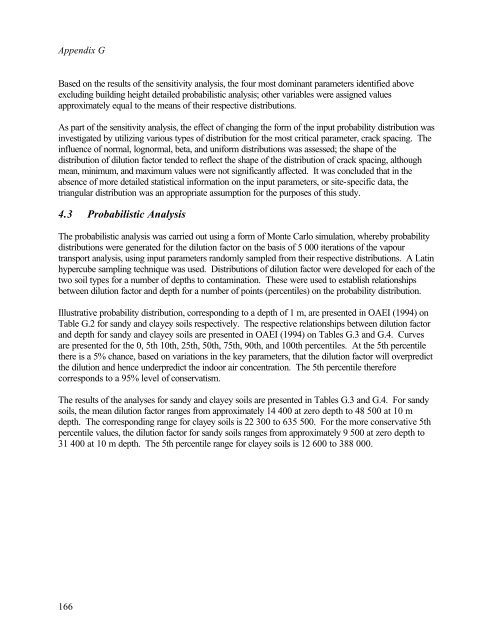Protocol for the Derivation of Environmental and Human ... - CCME
Protocol for the Derivation of Environmental and Human ... - CCME
Protocol for the Derivation of Environmental and Human ... - CCME
Create successful ePaper yourself
Turn your PDF publications into a flip-book with our unique Google optimized e-Paper software.
Appendix G<br />
Based on <strong>the</strong> results <strong>of</strong> <strong>the</strong> sensitivity analysis, <strong>the</strong> four most dominant parameters identified above<br />
excluding building height detailed probabilistic analysis; o<strong>the</strong>r variables were assigned values<br />
approximately equal to <strong>the</strong> means <strong>of</strong> <strong>the</strong>ir respective distributions.<br />
As part <strong>of</strong> <strong>the</strong> sensitivity analysis, <strong>the</strong> effect <strong>of</strong> changing <strong>the</strong> <strong>for</strong>m <strong>of</strong> <strong>the</strong> input probability distribution was<br />
investigated by utilizing various types <strong>of</strong> distribution <strong>for</strong> <strong>the</strong> most critical parameter, crack spacing. The<br />
influence <strong>of</strong> normal, lognormal, beta, <strong>and</strong> uni<strong>for</strong>m distributions was assessed; <strong>the</strong> shape <strong>of</strong> <strong>the</strong><br />
distribution <strong>of</strong> dilution factor tended to reflect <strong>the</strong> shape <strong>of</strong> <strong>the</strong> distribution <strong>of</strong> crack spacing, although<br />
mean, minimum, <strong>and</strong> maximum values were not significantly affected. It was concluded that in <strong>the</strong><br />
absence <strong>of</strong> more detailed statistical in<strong>for</strong>mation on <strong>the</strong> input parameters, or site-specific data, <strong>the</strong><br />
triangular distribution was an appropriate assumption <strong>for</strong> <strong>the</strong> purposes <strong>of</strong> this study.<br />
4.3 Probabilistic Analysis<br />
The probabilistic analysis was carried out using a <strong>for</strong>m <strong>of</strong> Monte Carlo simulation, whereby probability<br />
distributions were generated <strong>for</strong> <strong>the</strong> dilution factor on <strong>the</strong> basis <strong>of</strong> 5 000 iterations <strong>of</strong> <strong>the</strong> vapour<br />
transport analysis, using input parameters r<strong>and</strong>omly sampled from <strong>the</strong>ir respective distributions. A Latin<br />
hypercube sampling technique was used. Distributions <strong>of</strong> dilution factor were developed <strong>for</strong> each <strong>of</strong> <strong>the</strong><br />
two soil types <strong>for</strong> a number <strong>of</strong> depths to contamination. These were used to establish relationships<br />
between dilution factor <strong>and</strong> depth <strong>for</strong> a number <strong>of</strong> points (percentiles) on <strong>the</strong> probability distribution.<br />
Illustrative probability distribution, corresponding to a depth <strong>of</strong> 1 m, are presented in OAEI (1994) on<br />
Table G.2 <strong>for</strong> s<strong>and</strong>y <strong>and</strong> clayey soils respectively. The respective relationships between dilution factor<br />
<strong>and</strong> depth <strong>for</strong> s<strong>and</strong>y <strong>and</strong> clayey soils are presented in OAEI (1994) on Tables G.3 <strong>and</strong> G.4. Curves<br />
are presented <strong>for</strong> <strong>the</strong> 0, 5th 10th, 25th, 50th, 75th, 90th, <strong>and</strong> 100th percentiles. At <strong>the</strong> 5th percentile<br />
<strong>the</strong>re is a 5% chance, based on variations in <strong>the</strong> key parameters, that <strong>the</strong> dilution factor will overpredict<br />
<strong>the</strong> dilution <strong>and</strong> hence underpredict <strong>the</strong> indoor air concentration. The 5th percentile <strong>the</strong>re<strong>for</strong>e<br />
corresponds to a 95% level <strong>of</strong> conservatism.<br />
The results <strong>of</strong> <strong>the</strong> analyses <strong>for</strong> s<strong>and</strong>y <strong>and</strong> clayey soils are presented in Tables G.3 <strong>and</strong> G.4. For s<strong>and</strong>y<br />
soils, <strong>the</strong> mean dilution factor ranges from approximately 14 400 at zero depth to 48 500 at 10 m<br />
depth. The corresponding range <strong>for</strong> clayey soils is 22 300 to 635 500. For <strong>the</strong> more conservative 5th<br />
percentile values, <strong>the</strong> dilution factor <strong>for</strong> s<strong>and</strong>y soils ranges from approximately 9 500 at zero depth to<br />
31 400 at 10 m depth. The 5th percentile range <strong>for</strong> clayey soils is 12 600 to 388 000.<br />
166
















